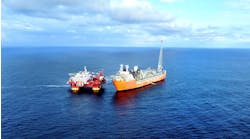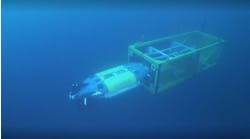Eldon Ball • Houston
Statoil awards subsea contracts
Statoil has awarded NKr 90 million for Skinfaks development and the Rimfaks expansion projects in the North Sea.
Of the contracts, NKr 420 million is for subsea work, including deals with Subsea 7 and Siapem. Located in the Tampen area, the two fields are being tied back to the Gullfaks C platform via existing infrastructure.
Subsea 7 will lay pipelines to tie the new subsea installations back to the group’s nearby Gullfaks C platform under a contract worth just under NKr 190 million. Subsea 7 will lay two 10-in. lines, each about 12-km long, and an 8-in. pipeline running for 4.5 km. They will link the new subsea templates being installed on the two fields to existing templates on Statoil’s Gullfaks satellites. Due to start next spring, laying work will be performed by Scandi Navica and is scheduled for completion in July 2006.
Saipem will carry out all subsea connection work, valued at NKr 230 million. Saipem will use the Normand Cutter and Far Sovereign vessels to install a number of structures and carry out 26 subsea connections.
Previously, Statoil awarded Transocean a drilling job worth some NKr 550 million and FMC Kongsberg Subsea a contract valued at just under NKr 500 million to deliver the subsea hardware.
In a separate deal, Fabricom will perform NKr 170 million in modifications on Gullfaks C.
Total investment in the fields is put at NKr 3.4 billion, with production due to start in November 2006. Recoverable reserves are estimated to be about 70 MMboe.
Statoil has a 61% interest in the development, where its partners are Petoro with 30% and Norsk Hydro with 9%.
Wet gas meters for Independence Hub
Roxar will supply its wet gas meters and sand monitoring system for the Independence Hub development in the Gulf of Mexico.
The meters detect and measure real-time hydrocarbon flow rates and water production as well as flow assurance input through the meters’ online detection of formation water being produced from the wells. Hub operator Anadarko Petroleum Corp. also selected Roxar’s new sand monitoring system for the subsea system design. The sand monitoring systems will tie into the wet gas meter. They are designed to reduce subsea integration issues and improve prediction of sand production rates.
The wet gas meter’s formation water detection function is an input parameter to control hydrates, corrosion, and scale in a subsea production system. This feature is considered important for the Independence Hub development’s deepwater wells, where hydrate formation is thought to be the largest risk to production integrity at such depths.
“Producing high gas fraction wells at these water depths requires the very best in flow assurance monitoring of individual fields and wells to ensure that hydrate formation does not affect production integrity,” says Bob Buck, Anadarko’s senior engineer for worldwide deepwater operations.
Independence Hub partners are operator Anadarko, Dominion Exploration & Production Inc., Kerr-McGee Oil & Gas Corp., Spinnaker Exploration Co., and Devon Energy Corp.
“The integration of our new sand monitoring system also gives the operator important information to control sand production and to predict erosion rates, without having the added burden of integrating a separate monitoring device subsea,” says Roxar CEO Sandy Esslemont.
Independence Hub, 165 mi east of New Orleans in 8,000 ft of water, will process production from 10 natural gas fields on Mississippi Canyon block 920, including Spiderman, San Jacinto, Jubilee, Vortex, Cheyenne, Merganser, Atlas NW, Mondo NW and Q developments. The fields, in water depths of 8,000 ft to 8,950 ft with the longest tie-back exceeding 45 mi, will operate the deepest development wells in the world.
The Independence Hub facility is capable of processing 850 MMcf/d of gas and 4,250 b/d of condensate. It is scheduled to go onstream in 3Q 2007.
Subsea 7 gets Australian job
Anzon Australia Ltd. has awarded a $13-million contract to Subsea 7 (Australia) Pty. Ltd for work at the Basker-Manta field development located offshore Victoria in the Bass Strait, in 150 m of water.
The contract includes the installation of the subsea equipment and moorings associated with the Extended Production Test (EPT) development. The development consists of a FPSO unit flexible flowline and control umbilical system and shuttle tanker mooring.
The project team will perform installation engineering, construction supervision, and overall project management. The offshore program is due to take place in August/September 2005 using a construction class vessel.
Martin Ridley, Subsea 7’s vice president, Asia Pacific said, “We are delighted to be working with Anzon Australia for the first time and look forward to undertaking this project in the Bass Strait.”
Total plans 35 subsea wells for Usan
Total says it will seek government approval to develop the Usan field offshore Nigeria with 35 subsea wells connected to a 2-MMbbl floating storage tanker.
Total recently found more oil in the Usan field following two appraisal wells that helped confirm an eastern extension of the field. The wells were drilled about 110 km offshore in water depths of 800 m.
A western extension of the Usan field was confirmed last year by two other appraisal wells. The field was discovered in 2002.
The offshore facility will have the capacity to process around 150,000 b/d. First oil is planned by 2010, Total said.•
Venture Production, operator for the Chestnut partnership, has signed a $64-million contract with Sevan Marine for the use of Sevan’s SSP 300 FPSO on the Chestnut field in 120 m of water in the central UK North Sea. The contract replaces a letter of intent signed earlier this year. The term of the contract is 30 months, with extension options for an additional 24 months.




